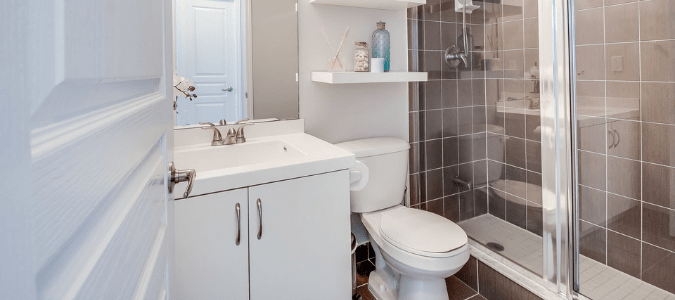
Leaks are among the most common plumbing issues homeowners have to deal with. If your toilet leaks when you flush it, you might have one (or more) of the following problems:
- Your supply valve or fill valve are loose.
- The nuts and bolts connecting the tank to other parts of the toilet aren’t tight.
- Your toilet tank is cracked.
- The flapper is not shutting correctly over the valve seat, causing the flush valve to leak into the bowl.
If you want to try to fix the leak on your own, take some time to thoroughly examine each part of the toilet, including the bowl, inside the tank and around the water supply valve. Sometimes, a leaky toilet can be fixed just by tightening nuts and bolts. In some cases, unfortunately, you will have to replace the entire toilet.
A toilet leak can quickly become a serious issue. Water leaks can cause damage to your bathroom or any rooms underneath. Standing water in a bathroom can also attract pests. The water damage, as well as all the wasted water over time, can turn into quite a costly problem over time.
If you don’t have the tools to fix a toilet leak, or aren’t entirely sure about the cause of the leak, contact a plumber for peace of mind. Simple mistakes, such as tightening bolts too tight or failing to notice cracks in the tank, may cause further damage and unnecessary headaches. A professional will be able to properly assess and quickly fix the problems with a guarantee that you will get back to using your toilet in no time.
If you have some experience with plumbing problems and decide to go the do-it-yourself route, this blog post will provide you with more information on common toilet issues.
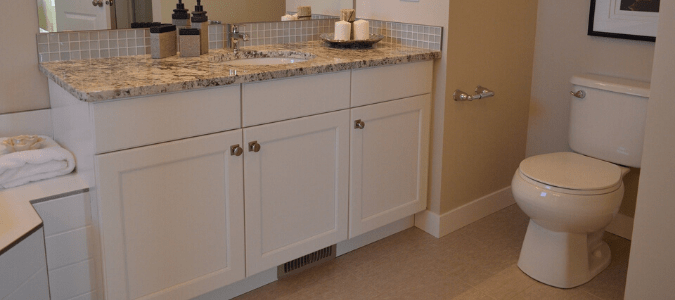
How To Fix A Leaking Toilet Tank
The first step in fixing your leaking toilet tank is to determine where the leak is coming from. As we’ve already mentioned, this might involve just tightening a bolt. Before you grab a wrench, though, take a look around the toilet tank and check for any hairline cracks. If your toilet tank isn’t cracked, there are a few possible components that could be responsible for your problem: the flapper, gasket or water supply line. We’ll address each of these problems in more detail.
However, before you get started, there are some things you should keep in mind. Overtightening the fittings or failing to take precautions may cause more damage than you started with. To be on the safe side, wear rubber gloves to avoid contact with wastewater and keep a bucket and towels nearby to catch any water that might escape from your toilet tank. Turn off the water supply before tightening or loosening parts of the toilet where water travels. Let the water drain fully by flushing the toilet until all of the water is gone.
If Your Flapper Is The Problem
The flapper is the part of the toilet that lifts up when you flush it. By releasing the flapper from the valve seat, water can flow through the tank into the bowl and push waste away. If the flapper doesn’t sit where it’s supposed to, the toilet doesn’t run smoothly. Another way you might know the issue is with your flapper is when your toilet flushes twice.
Squeeze a few drops of food coloring into the toilet tank and then wait for a couple of minutes. If the food coloring leaks into the bowl without flushing the toilet, your flapper probably isn’t sitting correctly. Once you have checked for this, you’ll want to turn off your water supply at the shutoff valve and flush the toilet until all the water has escaped from the tank. Place your bucket under the toilet tank to catch any water that escapes, or mop up any water that remains on the floor.
Next, remove your toilet tank lid and examine your flapper. If the rubber is no longer soft and pliable, you can buy an inexpensive replacement at the hardware store. To change it out, snap off your old flapper to removing it from the chain that leads to the flush handle. Then, pop the new flapper into place and attach it to the flush handle chain. Go ahead and turn the water back on and allow your tank to fill up with water.
If you checked and the flapper properly fits and is working smoothly, look for other sources of the leak.
If Your Gasket Is The Problem
To determine if your gasket is the problem, you’ll need to disconnect your toilet tank from the rest of the toilet. Due to the heavy weight of a toilet tank and the complexity of removing and then securing a toilet tank, many homeowners opt to contact a professional to handle the next steps. If you decide to try fixing this problem yourself, you will need a second person there to help you take the toilet tank off. To do so, you’ll need to:
- Turn off the water supply line and flush until the tank has emptied.
- Loosen the nuts that secure the hold-down bolts, which may require you holding the top of the bolt with a screwdriver while you use a wrench to loosen the nuts.
- Loosen the jamb nut that secures the water supply line to the tank.
- Pull the tank free from the bowl.
- Check to see if the rubber gasket is dried out or cracked (if so, you’ll need to replace it).
To replace your gasket, you’ll simply need to remove your old gasket, which should pop right off, then secure your new gasket into place. Once that’s done, you can place your tank back on top of the bowl and insert the hold-down bolts. At that point, you can tighten the nuts, being careful not to overtighten, as this can result in cracks in the porcelain.
Once you have finished, you’ll need to turn your water back on and allow your tank to fill up again.
If Your Water Supply Line Is The Problem
The tank is not the only place where water may leak. Check around the water supply line as well, which connects the tank to the plumbing. Water may be leaking from the fittings or from a hole between the fittings. If you’re not sure, run your hand down the supply line. Damp areas may be a sign that the line is leaking.
If water is leaking from these fittings, a quick tightening with a wrench should do the trick. Make sure not to overtighten these nuts, as they can easily become stripped and result in additional damage. To avoid any issues, try tightening them by hand, then using a wrench to turn them an additional quarter of a turn. If there are holes in your water supply line, you may have to contact a plumber and make those repairs.
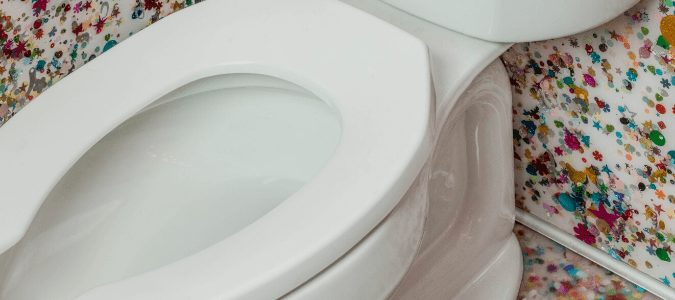
Toilet Bowl Slowly Drains: What’s Happening?
If your toilet bowl drains slowly and the water level periodically lowers when it’s not in use, you might have a leak. You may also have a clog or blocked vents preventing the proper flow of water and waste.
Fixing a clogged toilet might be quick and easy, but it may also require professional help. Start by determining whether it’s a clog by testing your toilet’s drainage. Once your toilet fills up with water, take off your toilet tank lid. Then, slightly lift your flapper which should result in your toilet flushing. If your toilet doesn’t flush, this can indicate that your toilet has an obstruction. If that’s the case, you can try pushing a plunger up and down several times in quick succession to see if you can push through small items that may be clogging the drain.
If the plunger isn’t doing the trick, take a listen for gurgling noises in drains around the bathroom. This could be a sign that the vents are blocked and that water cannot flow properly. Fixing this problem may require a professional to properly find the source of the blockage and unclog the area.
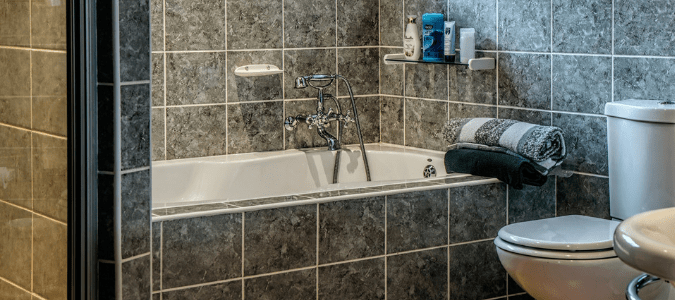
Is Your Toilet Leaking Through The Ceiling?
One of the most serious problems you can have in the bathroom is a toilet that is leaking through the ceiling. If you notice a leak from the ceiling that seems to be coming from a bathroom upstairs, take immediate action. Putting off the problem will only cause further (and more expensive) water damage.
If the toilet is leaking from the ceiling, take a look at the area where the base of the bowl is connected to the floor. A wax ring keeps the connection secure, but this component can break or crack over time. If you notice damage to this area, reach out to a professional for a replacement.
That said, the problem may not even be the toilet. Leaky water supply lines, drain pipes, showers and bathtubs may also cause water damage that reaches multiple floors. How can you tell where the problem is coming from? If you leave some water in the bottom of the bathtub or shower for several minutes and the water remains where it is, the toilet is probably the culprit.
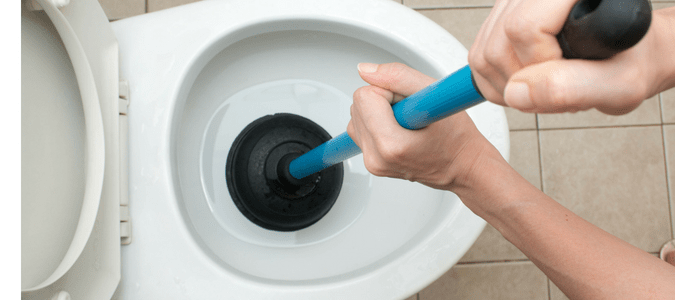
When To Replace Your Toilet And Its Parts
Many homeowners have no idea of the life expectancy of their plumbing and end up wondering when to replace their toilet or how long garbage disposals last. It may be time to replace your toilet if you’re experiencing one, or many, of the following:
- More regular or extensive repairs
- Frequent clogs
- Crack or cracks in the porcelain
- Visual scratches which leave your toilet looking dirty even after cleaning
Even when a toilet is working, some homeowners opt for replacement with a low-flush model in order to save money and water.
Most parts of your toilet should be replaced every five years. This includes the flapper or the water supply line that keeps your water moving where it’s supposed to go. After five years, these parts are likely to become loose or suffer damage that can cause leaks.
The bowl itself should not have to be replaced unless it’s cracked. However, scratches in the porcelain may also be a sign that the bowl or outer tank is wearing down and should be replaced. Scratches or damage can develop from cleaning. You can replace these parts as soon as you recognize damage, as just one flush can cause a small crack to result in a huge amount of damage to your home.
Low-flush toilets may need to be serviced or replaced if they frequently clog. Quite simply, after several years of use, a low-flush toilet may not work as efficiently as it used to. Save yourself the wasted water (and money) by replacing the toilet with a newer model.
ABC Can Handle Your Plumbing Issues
Toilets are surprisingly complex. Often, the quickest and easiest way to get your toilet problem fixed is by contacting a reliable plumber. The licensed specialists at ABC Home & Commercial Services are available 24 hours a day, 7 days a week to help with any plumbing problem. Our pros can offer you honest advice on whether it may be time to replace your toilet, as well as recommendations for new, more water-efficient equipment.
